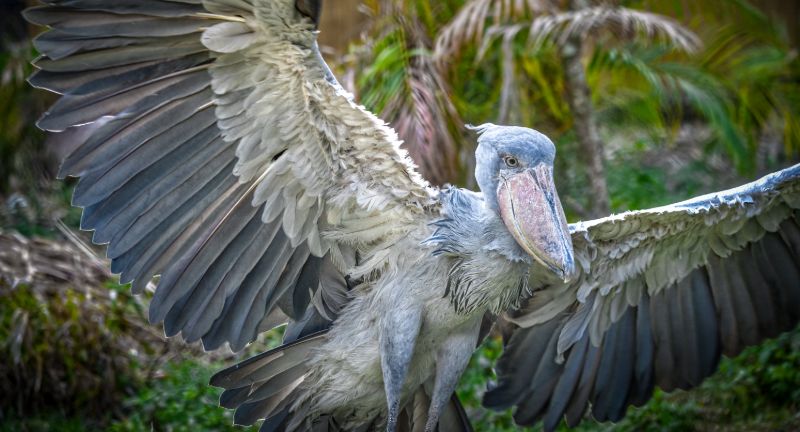NEWS
23 Mysterious Creatures That Give Cryptozoology Credibility
Published
1 month agoon

Shutterstock
Cryptozoology often bridges the gap between myths and science, inspiring curiosity about creatures that defy explanation. While skeptics may dismiss it as pseudoscience, many mysterious animals have baffled researchers for decades. Some were once considered cryptids until proven real, while others remain tantalizing enigmas. Explore these fascinating creatures that lend credibility to the field of cryptozoology.
The Giant Squid: A Deep-Sea Legend

Shutterstock
Long dismissed as sailor tales, the giant squid was finally captured on camera in its natural habitat in 2004. These massive creatures, with eyes the size of basketballs, can grow up to 43 feet long. Their elusive nature and preference for deep ocean waters made them difficult to study for centuries. The discovery of the giant squid proves that mythical sea monsters can indeed be real.
The Komodo Dragon: A Real-Life Dragon

Shutterstock
Komodo dragons were once dismissed as legends by Western explorers until their discovery in Indonesia in 1910. These massive lizards can grow over 10 feet long and possess venomous saliva. With their fearsome appearance and predatory skills, they live up to their dragon-like reputation. Their existence reminds us how local legends often hold grains of truth.
The Coelacanth: A Living Fossil

Shutterstock
Believed to have gone extinct 66 million years ago, the coelacanth shocked scientists when it was rediscovered in 1938. This deep-sea fish possesses unique limb-like fins, resembling a transitional species. Its unexpected survival challenges assumptions about extinction and evolution. The coelacanth exemplifies the surprises still lurking in Earth’s oceans.
The Platypus: Nature’s Oddity

Shutterstock
When European scientists first encountered the platypus in 1798, they thought it was a hoax. With its duckbill, webbed feet, and ability to lay eggs, this mammal defies conventional biology. Native to Australia, the platypus continues to fascinate researchers with its unique evolutionary path. It serves as a reminder of how nature can defy expectations.
The Okapi: The Forest Giraffe

Shutterstock
Once thought to be a mythical beast, the okapi was discovered in the dense forests of the Congo in 1901. With its zebra-like stripes and giraffe-like build, the okapi remained hidden from scientists for centuries. Its elusive nature demonstrates how easily creatures can escape detection in remote habitats. Today, it stands as a symbol of cryptozoology’s potential to uncover the unknown.
The Yeti Crab: A Deep-Sea Marvel

Shutterstock
Discovered near hydrothermal vents in 2005, the yeti crab gets its name from its hairy claws. This unique creature thrives in extreme environments, far from sunlight. Its peculiar features challenge our understanding of marine biodiversity. The yeti crab highlights the incredible adaptability of life on Earth.
The Saola: The Asian Unicorn

Shutterstock
Discovered in 1992 in Vietnam, the saola is one of the most elusive mammals known. With its striking horns and graceful appearance, it’s often called the “Asian unicorn.” Its rarity and habitat in dense forests make it incredibly difficult to study. The saola’s discovery renewed hope for finding other unknown species.
The Giant Pangolin: A Rare Armored Giant

Shutterstock
The giant pangolin is the largest species of pangolin, known for its armor-like scales. Native to Africa, it is nocturnal and elusive, making sightings extremely rare. Despite its large size, it moves silently through dense forests. The giant pangolin’s rarity fuels conservation efforts and intrigue among researchers.
The Kakapo: A Flightless Night Parrot

Shutterstock
The kakapo, a flightless parrot from New Zealand, is one of the rarest birds in the world. Known for its nocturnal habits and unique mating calls, it has fascinated scientists and conservationists alike. Once thought extinct, a small population was rediscovered in the 1970s. Intensive conservation efforts aim to protect this remarkable species.
The Bloop: A Mysterious Ocean Sound

Shutterstock
First detected in 1997, the Bloop is one of the loudest underwater sounds ever recorded. Its origin remains a mystery, with some speculating it could come from an unknown marine creature. While later analysis suggested ice movement, the mystery lingers. The Bloop highlights how little we know about the ocean’s depths.
The Gobi Bear: A Desert Survivor

Wikipedia
The Gobi bear is a critically endangered species that lives in one of the harshest environments on Earth—the Gobi Desert. With fewer than 50 individuals estimated to remain, it’s rarely seen by humans. Adapted to survive with limited food and water, it embodies resilience. The Gobi bear is a symbol of the fragile balance of desert ecosystems.
The Megamouth Shark: A Deep-Sea Mystery

Shutterstock
Discovered in 1976, the megamouth shark is one of the rarest shark species. It’s named for its massive mouth, which it uses to filter-feed on plankton. Found in deep waters, it has been sighted only a handful of times. Its elusive nature makes it a fascinating subject for marine biologists.
The Andean Mountain Cat: A Ghost of the Andes

Shutterstock
The Andean mountain cat is one of the rarest and least-studied wild cats. Found in the high altitudes of the Andes, it is known for its thick fur and elusive behavior. Sightings are incredibly rare due to its remote habitat. Its mysterious existence continues to intrigue wildlife researchers.
The Vaquita: The World’s Rarest Marine Mammal

Shutterstock
The vaquita is a small porpoise found only in the northern Gulf of California. With fewer than 20 individuals remaining, it is critically endangered. Known for its shy nature, the vaquita is rarely seen in the wild. Its plight underscores the urgent need for marine conservation efforts.
The Sunda Clouded Leopard: A Jungle Phantom

Shutterstock
Native to the rainforests of Borneo and Sumatra, the Sunda clouded leopard is a rarely seen predator. Its striking cloud-like coat pattern provides excellent camouflage. First classified as a separate species in 2006, it remains one of the least-understood big cats. Its elusive nature adds to its mystique.
The Aye-Aye: Madagascar’s Nocturnal Enigma

Shutterstock
The aye-aye is a unique lemur found only in Madagascar. Known for its large eyes, long fingers, and peculiar feeding habits, it often inspires superstition among locals. Despite its unusual appearance, the aye-aye plays a vital role in its ecosystem. Its survival highlights the importance of preserving Madagascar’s biodiversity.
The Irrawaddy Dolphin: A Freshwater Wonder

Shutterstock
The Irrawaddy dolphin is a unique freshwater species found in rivers and estuaries of Southeast Asia. Its rounded forehead and playful behavior make it a favorite among locals and tourists. Threatened by habitat loss and fishing practices, its population is declining. Efforts to protect the Irrawaddy dolphin highlight the need for sustainable practices in freshwater ecosystems.
The Devil’s Hole Pupfish: A Desert Survivor

Wikipedia
The Devil’s Hole pupfish lives in a single water-filled cavern in Nevada. As one of the most isolated species on Earth, it has adapted to extreme conditions. With fewer than 200 individuals, it’s a critical focus for conservation efforts. Its survival offers insights into evolution and species resilience.
The Tree Lobster: A Resurrected Relic

Shutterstock
Once thought extinct, the tree lobster was rediscovered on a remote island near Australia in 2001. This giant stick insect earned its name due to its size and tree-dwelling habits. Its survival story demonstrates nature’s resilience in the face of adversity. Conservation efforts aim to ensure its continued existence.
The Oarfish: A Sea Serpent Unveiled

Shutterstock
Often mistaken for a sea serpent, the oarfish is the longest bony fish in the world, growing up to 36 feet. Its silvery body and undulating movements contribute to its mythical reputation. Found in deep ocean waters, the oarfish occasionally washes ashore during storms. It is a living inspiration for ancient maritime legends.
The Golden Mole: A Blind Burrower

Shutterstock
Golden moles are small, blind mammals that live underground in parts of Africa. With iridescent fur that seems to shimmer in sunlight, they are adapted to life in the dark. Their unique biology and behavior make them a subject of fascination. These elusive creatures remind us of the hidden wonders of the animal kingdom.
The Quokka: The World’s Happiest Animal

Wikipedia
Known for their ever-smiling faces, quokkas are marsupials native to Australia. These friendly and curious animals are often photographed by tourists. Despite their charm, they are vulnerable to habitat loss and predators. Efforts to protect quokkas emphasize the importance of preserving biodiversity.
The Shoebill: A Dinosaur-like Stork

Shutterstock
The shoebill, with its massive beak and prehistoric appearance, is a stork-like bird found in African wetlands. Known for its patience while hunting, it remains motionless for hours before striking its prey. Its distinct look and behavior have earned it a reputation as one of the most fascinating birds in the world. Conservation efforts aim to protect its dwindling wetland habitats.
Conclusion

Shutterstock
From forest-dwelling mammals to deep-sea enigmas, these 23 creatures demonstrate the enduring mysteries of our world. Cryptozoology encourages us to keep an open mind about the unknown and explore uncharted territories. Many of these animals were once dismissed as myths, proving that science and discovery go hand in hand. Who knows what other incredible creatures remain hidden, waiting to be found?
Related Topics:

More From Lifestylogy
-


23 Cars So Reliable Drivers Keep Them for Over A…
-


23 Things Adult Men Should Not Be Caught Wearing
-


23 Tiniest Creatures In The World
-


21 Mistakes to Avoid Immediately After Botox
-


25 Fruits That Last The Longest After Purchase
-


Enhance Your Garden’s Scent with These Fragrant Rose Varieties
-


23 UGG Care Hacks for Lasting Comfort and Style
-


23 Clever Coffee Filter Hacks That Go Beyond Brewing
-


23 Intriguing Things To Know About Raccoons In America